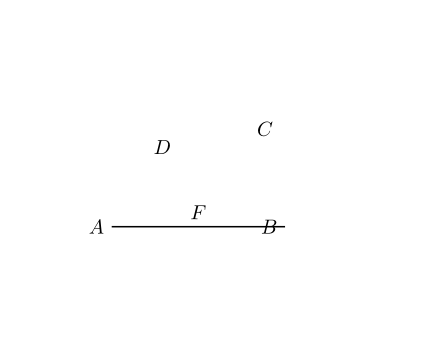提问于:
浏览数:
4681
% MWE如下:
%----如何定义两条线段AD与BC延长线的交点 F ?
%
%----xelatex编译
```
\documentclass{article}
\usepackage{xeCJK}%使用xeCJK中文处理宏包
\usepackage{amsmath,amssymb,bm}%ams数学符号
\usepackage{tikz}
\usetikzlibrary{arrows,intersections}
\usetikzlibrary{positioning,backgrounds}
\usetikzlibrary{fadings}
\usetikzlibrary{patterns}
\usetikzlibrary{calc}
\usetikzlibrary{shadings}
\pgfdeclarelayer{background}
\pgfdeclarelayer{foreground}
\pgfsetlayers{background,main,foreground}
\usepackage{verbatim}
\begin{document}
\begin{tikzpicture}[scale=1.5,line width=0.75pt]
%点A
\coordinate (A) at (-1,0);
\node[left] at (A) {$A$};
%点D
\coordinate (D) at ([shift=(50:1.2cm)]A);
\node[left] at (D) {$D$};
%点B
\coordinate (B) at (1,0);
\node[left] at (B) {$B$};
%点C
\coordinate (C) at ([shift=(110:1.2cm)]B);
\node[right] at (C) {$C$};
%失败尝试--定义直线AD与BC交点F
\coordinate (F1) at ($(A)!2!0:(D)$);
\coordinate (F2) at ($(B)!2!0:(C)$);
\path[name path=x] (A)--(F1);
\path[name path=y] (B)--(F2);
\path[name intersections={of=x and y, name=i}] coordinate (F);
\node[above] at (F) {$F$};
%失败尝试--定义直线AD与BC交点F
%连线FAB
\draw (F)--(A)--(B)--cycle;
\end{tikzpicture}
\end{document}
```
%========
失败的运行效果图,如下:

4 回答
1
<p></p><p>又不是做数学题,把直线路径加长一点不就行了。</p><pre class="brush:plain;toolbar:false">\documentclass[tikz]{standalone}
\usetikzlibrary{intersections}
\usetikzlibrary{positioning,backgrounds}
\begin{document}
\begin{tikzpicture}[scale=1.5,line width=0.75pt]
%点A
\coordinate (A) at (-1,0);
\node[left] at (A) {$A$};
%点D
\coordinate (D) at ([shift=(50:1.2cm)]A);
\fill (D) circle (1pt) node[left] {$D$};
%点B
\coordinate (B) at (1,0);
\node[right] at (B) {$B$};
%点C
\coordinate (C) at ([shift=(110:1.2cm)]B);
\fill (C) circle (1pt) node[right] {$C$};
\path [name path =AD] (A)--++(50:2.5);
\path [name path =BC] (B)--++(110:2.5);
\fill [name intersections={of=AD and BC, by={F}}] (F) circle(1pt) node [above] {$F$};
\draw[dashed] (F)--(D)(F)--(C);
\draw (D)--(A)--(B)--(C);
\end{tikzpicture}
\end{document}</pre><p><img src="/data/ueditor/php/upload/image/20190910/1568125999626288.png" title="1568125999626288.png" alt="TIM4.png"/></p><p></p>
-
非常感谢! – ChangChun_D 2019-09-16 16:22 回复
1
```tex
%----当两条线段无交点,但所在直线有交点时,如何定义两条线段AD与BC延长线的交点 F ?
%
%----xelatex编译
\documentclass{article}
\usepackage{xeCJK}%使用xeCJK中文处理宏包
\usepackage{amsmath,amssymb,bm}%ams数学符号
\usepackage{tikz}
\usetikzlibrary{arrows,intersections}
\usetikzlibrary{positioning,backgrounds}
\usetikzlibrary{fadings}
\usetikzlibrary{patterns}
\usetikzlibrary{calc}
\usetikzlibrary{shadings}
\pgfdeclarelayer{background}
\pgfdeclarelayer{foreground}
\pgfsetlayers{background,main,foreground}
\usepackage{verbatim}
\begin{document}
\begin{tikzpicture}[scale=1.5,line width=0.75pt]
%点A
\coordinate (A) at (-1,0);
\node[left] at (A) {$A$};
%点D
\coordinate (D) at ([shift=(50:1.2cm)]A);
\node[left] at (D) {$D$};
%点B
\coordinate (B) at (1,0);
\node[left] at (B) {$B$};
%点C
\coordinate (C) at ([shift=(110:1.2cm)]B);
\node[right] at (C) {$C$};
%%失败尝试--定义直线AD与BC交点F
% \coordinate (F1) at ($(A)!2!0:(D)$);
% \coordinate (F2) at ($(B)!2!0:(C)$);
%
% \path[name path=x] (A)--(F1);
% \path[name path=y] (B)--(F2);
% \path[name intersections={of=x and y, name=i}] coordinate (F);
% \node[above] at (F) {$F$};
%%失败尝试--定义直线AD与BC交点F
%成功尝试--定义直线AD与BC交点F
\path[name path=x] ($(A)!4!180:(D)$)--($(A)!4!0:(D)$);
\path[name path=y] ($(B)!4!0:(C)$)--($(B)!4!180:(C)$);
\path[name intersections={of=x and y,by=i}];
\coordinate (F) at (i);
\node[above] at (F) {$F$};
%成功尝试--定义直线AD与BC交点F
%连线FAB
\draw (F)--(A)--(B)--cycle;
\end{tikzpicture}
\end{document}
```
-
把失败的代码改一下,\path[name intersections={of=x and y, name=i}] coordinate (F)at(i-1); 再试试 – 咸菜的味道 2019-09-10 23:52 回复
1
tkz-euclide包,专门绘制平面几何图形的包(原包是法语包),我的博客已经给出了很多例子
https://yuxtech.github.io/2019/07/14/平面几何绘图示例/
```tex
\documentclass[tikz]{standalone}
\usepackage{tkz-euclide}%%%加载tkz-euclide包
\begin{document}
\begin{tikzpicture}[inner sep=1pt]
\tkzDefPoints{0/0/A,3/0/B,1/1/D,2/1/C}
%%等价于\coordinate(A)at(0,0);\coordinate(B)at(3,0);.....
\tkzInterLL(A,D)(B,C)\tkzGetPoint{F}
%%定义直线AD与BC的交点,得到交点F
\draw(A)node[below]{$A$}--(F)node[above]{$F$}--(B)node[below]{$B$}--cycle;
\draw(C)node[above right]{$C$}(D)node[above left]{$D$};
\tkzDrawPoints[size=2,fill=blue](A,B,C,D,F)
\end{tikzpicture}
```
0
%----当两条线段无交点,但所在直线有交点时,如何定义两条线段AD与BC延长线的交点 F ?
%
%----xelatex编译
\documentclass{article}
\usepackage{xeCJK}%使用xeCJK中文处理宏包
\usepackage{amsmath,amssymb,bm}%ams数学符号
\usepackage{tikz}
\usetikzlibrary{arrows,intersections}
\usetikzlibrary{positioning,backgrounds}
\usetikzlibrary{fadings}
\usetikzlibrary{patterns}
\usetikzlibrary{calc}
\usetikzlibrary{shadings}
\pgfdeclarelayer{background}
\pgfdeclarelayer{foreground}
\pgfsetlayers{background,main,foreground}
\begin{document}
\begin{tikzpicture}[scale=1.5,line width=0.75pt]
%点A
\coordinate (A) at (-1,0);
\node[left] at (A) {$A$};
%点D
\coordinate (D) at ([shift=(50:1.2cm)]A);
\node[left] at (D) {$D$};
%点B
\coordinate (B) at (1,0);
\node[left] at (B) {$B$};
%点C
\coordinate (C) at ([shift=(110:1.2cm)]B);
\node[right] at (C) {$C$};
\coordinate[label=above:$G$] (G) at (intersection of A--D and B--C);
\draw (G)--(A)--(B)--cycle;
\end{tikzpicture}
\end{document}
你的回答
请登录后回答
你的回答将会帮助更多人,请务必认真回答问题。
